2012年职称英语理工类语法复习:全部倒装与部分倒装
- 格式:doc
- 大小:21.00 KB
- 文档页数:1
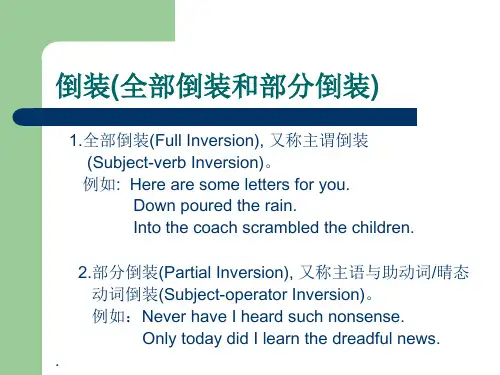
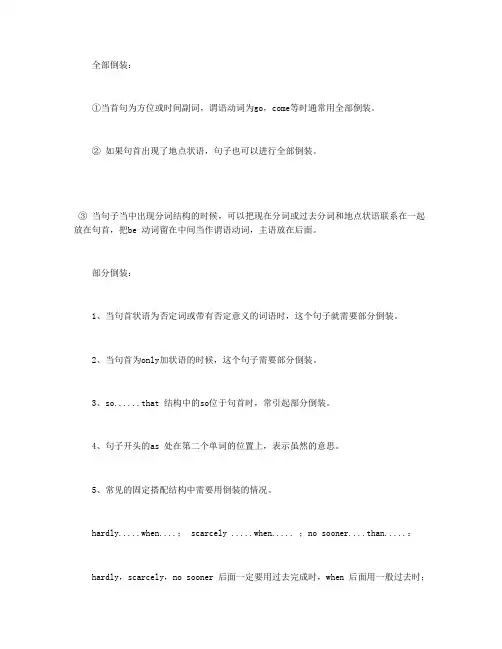
全部倒装:①当首句为方位或时间副词,谓语动词为go,come等时通常用全部倒装。
②如果句首出现了地点状语,句子也可以进行全部倒装。
③当句子当中出现分词结构的时候,可以把现在分词或过去分词和地点状语联系在一起放在句首,把be 动词留在中间当作谓语动词,主语放在后面。
部分倒装:1、当句首状语为否定词或带有否定意义的词语时,这个句子就需要部分倒装。
2、当句首为only加状语的时候,这个句子需要部分倒装。
3、so......that 结构中的so位于句首时,常引起部分倒装。
4、句子开头的as 处在第二个单词的位置上,表示虽然的意思。
5、常见的固定搭配结构中需要用倒装的情况。
hardly.....when....; scarcely .....when..... ;no sooner....than.....:hardly,scarcely,no sooner 后面一定要用过去完成时,when 后面用一般过去时;the more ......the more... 越....越.... ;实例练习(1)1.直到他完成使命(Not until he had fufilled/finished his mission)did he realize that he was seriously ill. (08.06)2. The witness was told that under no circumstance ( should he lie to the court ) 他都不应该对法庭撒谎。
(07.12)3. Only in the small town( does he feel secure and relaxed) 他才感觉安全和放松。
he feels secure and relaxed. (07.6)4. Not only ( did he charge me too much ) 他向我收费过高, but he didn't doa good repair job either. (06.6)5. Only after I found out the truth( did I realize (that) he was innocent ) 我才意识到他是无辜的。
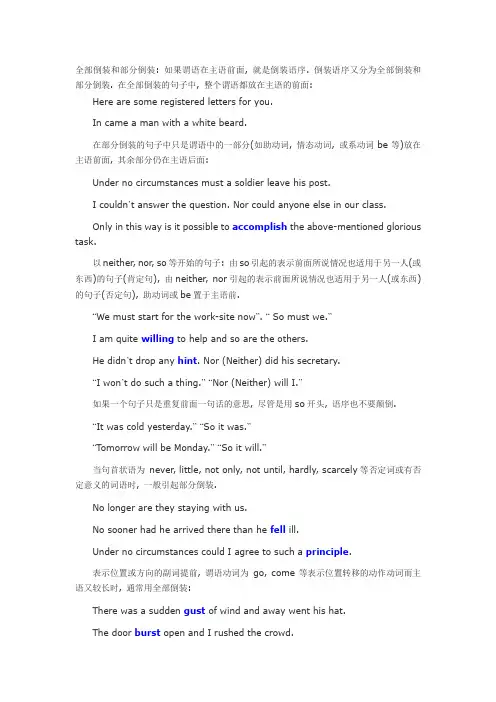
全部倒装和部分倒装: 如果谓语在主语前面, 就是倒装语序. 倒装语序又分为全部倒装和部分倒装. 在全部倒装的句子中, 整个谓语都放在主语的前面:Here are some registered letters for you.In came a man with a white beard.在部分倒装的句子中只是谓语中的一部分(如助动词, 情态动词, 或系动词be等)放在主语前面, 其余部分仍在主语后面:Under no circumstances must a soldier leave his post.I couldn’t answer the question. Nor could anyone else in our class.Only in this way is it possible to accomplish the above-mentioned glorious task.以neither, nor, so等开始的句子: 由so引起的表示前面所说情况也适用于另一人(或东西)的句子(肯定句), 由neither, nor引起的表示前面所说情况也适用于另一人(或东西)的句子(否定句), 助动词或be置于主语前.“We must start for the work-site now”. “ So must we.”I am quite willing to help and so are the others.He didn’t drop any hint. Nor (Neither) did his secretary.“I won’t do such a thing.”“Nor (Neither) will I.”如果一个句子只是重复前面一句话的意思, 尽管是用so开头, 语序也不要颠倒.“It was cold yesterday.”“So it was.”“Tomorrow will be Monday.”“So it will.”当句首状语为never, little, not only, not until, hardly, scarcely等否定词或有否定意义的词语时, 一般引起部分倒装.No longer are they staying with us.No sooner had he arrived there than he fell ill.Under no circumstances could I agree to such a principle.表示位置或方向的副词提前, 谓语动词为go, come等表示位置转移的动作动词而主语又较长时, 通常用全部倒装:There was a sudden gust of wind and away went his hat.The door burst open and I rushed the crowd.There comes the bus!Now comes your turn.1.如果主语是代词, 仍用正常语序:There comes your turn.有here引起, 谓语为be的句子, 也要倒装:Here is China’s largest tropical forest.Here are some picture-books.2.如果主语是代词, 仍用正常语序:Here we are. This is the new railway station.“Give me some paper.”“Here you are.”3.表语和系动词提前:介词短语: On the other side was northern Xinjiang.Near the southern end of the village was a large pear orchard.形容词: Very important in the farmer’s life is the radio weather report.Worst of all were the humiliations he suffered.副词: Below is a restaurant.Southwest of the reservoir were 2,000 acres of sandy wasteland.分词: Housed in the Cultural Palace are a library, an auditorium and recreation rooms.Hidden underground is a wealth of gold, silver, copper, lead and zink.Lying on the floor was a boy aged about 17.Standing beside the table was an interpreter.4 句首状语若由only + 副词, only + 介词词组, only + 状语从句构成, 引起局部倒装:Only yesterday did he find out that his watch was missing.Only through sheer luck did he manage to get some tickets.Only because there were some cancelled bookings did he get some tickets in the end.有not only开头的句子或分句, 往往引起局部倒装:Not only did he complain about the food, he also refused to pay for it.Not only did the garage overcharge me, but they hadn’t done a very good repair job either.1、词类冠词:关注冠词表示特指、泛指、类指的用法。
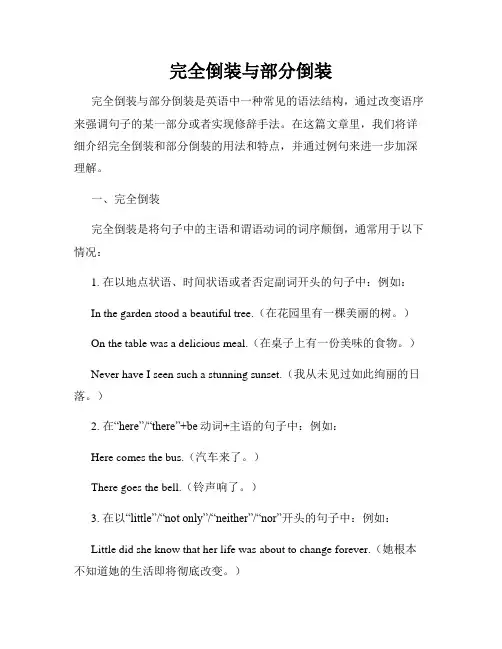
完全倒装与部分倒装完全倒装与部分倒装是英语中一种常见的语法结构,通过改变语序来强调句子的某一部分或者实现修辞手法。
在这篇文章里,我们将详细介绍完全倒装和部分倒装的用法和特点,并通过例句来进一步加深理解。
一、完全倒装完全倒装是将句子中的主语和谓语动词的词序颠倒,通常用于以下情况:1. 在以地点状语、时间状语或者否定副词开头的句子中:例如:In the garden stood a beautiful tree.(在花园里有一棵美丽的树。
)On the table was a delicious meal.(在桌子上有一份美味的食物。
)Never have I seen such a stunning sunset.(我从未见过如此绚丽的日落。
)2. 在“here”/“there”+be动词+主语的句子中:例如:Here comes the bus.(汽车来了。
)There goes the bell.(铃声响了。
)3. 在以“little”/“not only”/“neither”/“nor”开头的句子中:例如:Little did she know that her life was about to change forever.(她根本不知道她的生活即将彻底改变。
)Not only is he intelligent, but he is also kind-hearted.(他不仅聪明,而且心地善良。
)Neither did I agree with his decision, nor did I understand his reasoning.(我既不同意他的决定,也不理解他的理由。
)二、部分倒装部分倒装是将助动词、情态动词或者“be”动词与主语的词序颠倒,同样用于强调句子的某一部分或者实现修辞手法。
常见的部分倒装情况包括:1. 在以否定词开头的句子中:例如:Never have I been so inspired.(我从未如此受到鼓舞。
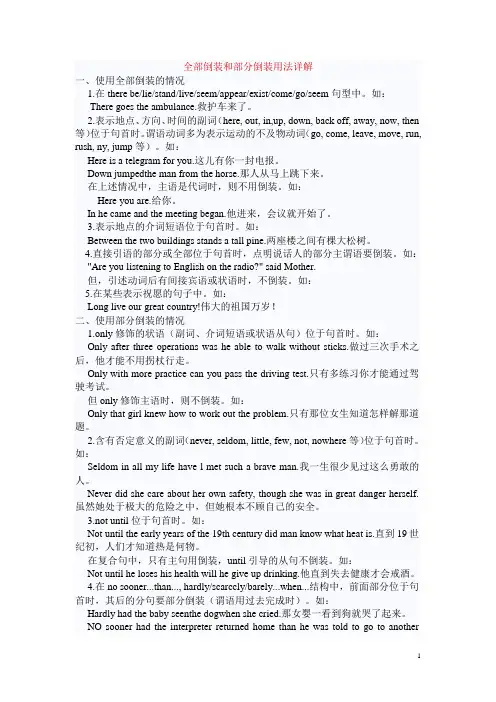
全部倒装和部分倒装用法详解一、使用全部倒装的情况1.在there be/lie/stand/live/seem/appear/exist/come/go/seem句型中。
如:There goes the ambulance.救护车来了。
2.表示地点、方向、时间的副词(here, out, in,up, down, back off, away, now, then 等)位于句首时。
谓语动词多为表示运动的不及物动词(go, come, leave, move, run, rush, ny, jump等)。
如:Here is a telegram for you.这儿有你一封电报。
Down jumpedthe man from the horse.那人从马上跳下来。
在上述情况中,主语是代词时,则不用倒装。
如:Here you are.给你。
In he came and the meeting began.他进来,会议就开始了。
3.表示地点的介词短语位于句首时。
如:Between the two buildings stands a tall pine.两座楼之间有棵大松树。
4.直接引语的部分或全部位于句首时,点明说话人的部分主谓语要倒装。
如:"Are you listening to English on the radio?" said Mother.但,引述动词后有间接宾语或状语时,不倒装。
如:5.在某些表示祝愿的句子中。
如:Long live our great country!伟大的祖国万岁!二、使用部分倒装的情况1.only修饰的状语(副词、介词短语或状语从句)位于句首时。
如:Only after three operations was he able to walk without sticks.做过三次手术之后,他才能不用拐杖行走。
Only with more practice can you pass the driving test.只有多练习你才能通过驾驶考试。
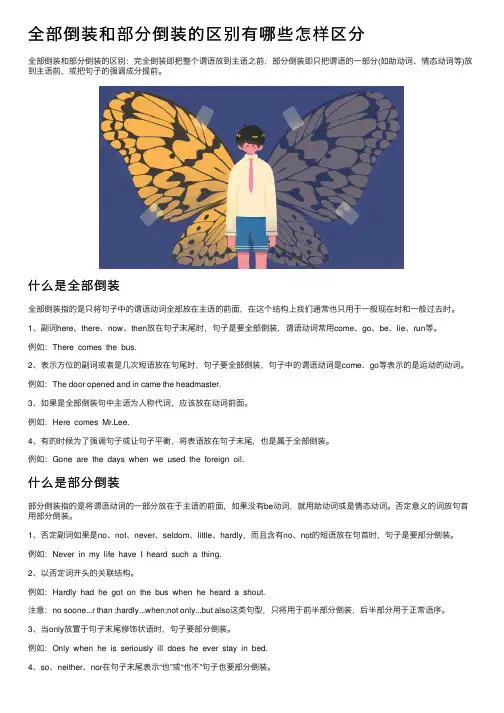
全部倒装和部分倒装的区别有哪些怎样区分全部倒装和部分倒装的区别:完全倒装即把整个谓语放到主语之前,部分倒装即只把谓语的⼀部分(如助动词、情态动词等)放到主语前,或把句⼦的强调成分提前。
什么是全部倒装全部倒装指的是只将句⼦中的谓语动词全部放在主语的前⾯,在这个结构上我们通常也只⽤于⼀般现在时和⼀般过去时。
1、副词here、there、now、then放在句⼦末尾时,句⼦是要全部倒装,谓语动词常⽤come、go、be、lie、run等。
例如:There comes the bus.2、表⽰⽅位的副词或者是⼏次短语放在句尾时,句⼦要全部倒装,句⼦中的谓语动词是come、go等表⽰的是运动的动词。
例如:The door opened and in came the headmaster.3、如果是全部倒装句中主语为⼈称代词,应该放在动词前⾯。
例如:Here comes Mr.Lee. 4、有的时候为了强调句⼦或让句⼦平衡,将表语放在句⼦末尾,也是属于全部倒装。
例如:Gone are the days when we used the foreign oil. 什么是部分倒装部分倒装指的是将谓语动词的⼀部分放在于主语的前⾯,如果没有be动词,就⽤助动词或是情态动词。
否定意义的词放句⾸⽤部分倒装。
1、否定副词如果是no、not、never、seldom、little、hardly,⽽且含有no、not的短语放在句⾸时,句⼦是要部分倒装。
例如:Never in my life have I heard such a thing.2、以否定词开头的关联结构。
例如:Hardly had he got on the bus when he heard a shout. 注意:no soone...r than ;hardly...when;not only...but also这类句型,只将⽤于前半部分倒装,后半部分⽤于正常语序。
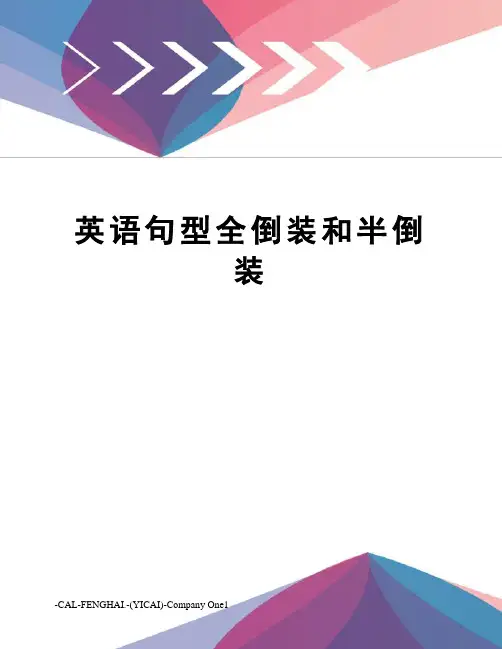
英语句型全倒装和半倒装-CAL-FENGHAI.-(YICAI)-Company One1全倒装和半倒装1. 完全倒装1) 完全倒装即把整个谓语放到主语之前(是整个谓语动词,而非助动词)。
例如:In came the teacher and the class began. (老师走了进来,然后开始上课。
) (这类词通常有:away in out up)2) there引出的完全倒装句:除了最常见的there be句型以外,there还可以接appear, exist, lie, remain, seem to be, stand等,一般都译成"有"的含义,构成完全倒装句。
例如:There appeared to be a man in black in the distance.(远处有个穿黑色衣服的人。
)3) 由地点和时间副词引出的完全倒装句:以地点副词here, there和时间副词now, then 开头,后面的动词是be, come, exist, fall, follow, go, lie, remain, seem, stand等,而主语又是名词时,构成完全倒装句。
例:Under that tree sits a beautiful girl.(那棵树下坐着一位美丽的姑娘。
)例:_________ from the tenth floor when the policeman pointed his pistol at him.A) Jumped down the burglar B) Down the burglar jumpedC) The burglar jumps down D) Down jumped the burglar答案是D) Down jumped the burglar。
因为地点状语Down位于句首应该用完全倒装,整个谓语动词应位于主语之前。
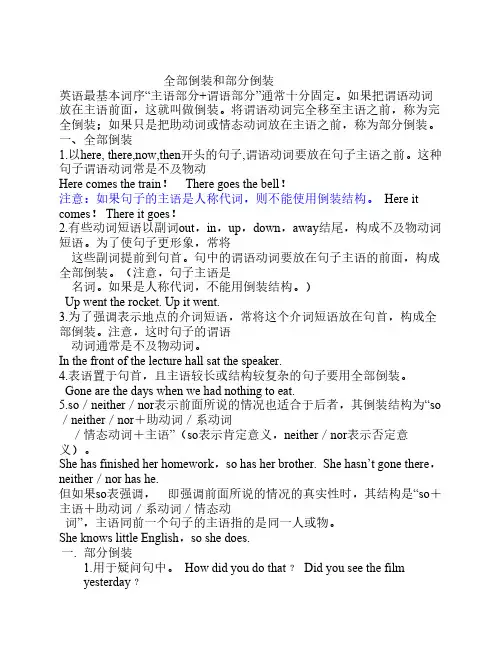
全部倒装和部分倒装英语最基本词序“主语部分+谓语部分”通常十分固定。
如果把谓语动词放在主语前面,这就叫做倒装。
将谓语动词完全移至主语之前,称为完全倒装;如果只是把助动词或情态动词放在主语之前,称为部分倒装。
一、全部倒装1.以here, there,now,then开头的句子,谓语动词要放在句子主语之前。
这种句子谓语动词常是不及物动Here comes the train! There goes the bell!注意:如果句子的主语是人称代词,则不能使用倒装结构。
Here it comes! There it goes!2.有些动词短语以副词out,in,up,down,away结尾,构成不及物动词短语。
为了使句子更形象,常将这些副词提前到句首。
句中的谓语动词要放在句子主语的前面,构成全部倒装。
(注意,句子主语是名词。
如果是人称代词,不能用倒装结构。
)Up went the rocket. Up it went.3.为了强调表示地点的介词短语,常将这个介词短语放在句首,构成全部倒装。
注意,这时句子的谓语动词通常是不及物动词。
In the front of the lecture hall sat the speaker.4.表语置于句首,且主语较长或结构较复杂的句子要用全部倒装。
Gone are the days when we had nothing to eat.5.so/neither/nor表示前面所说的情况也适合于后者,其倒装结构为“so /neither/nor+助动词/系动词/情态动词+主语”(so表示肯定意义,neither/nor表示否定意义)。
She has finished her homework,so has her brother. She hasn’t gone there,neither/nor has he.但如果so表强调,即强调前面所说的情况的真实性时,其结构是“so+主语+助动词/系动词/情态动词”,主语同前一个句子的主语指的是同一人或物。
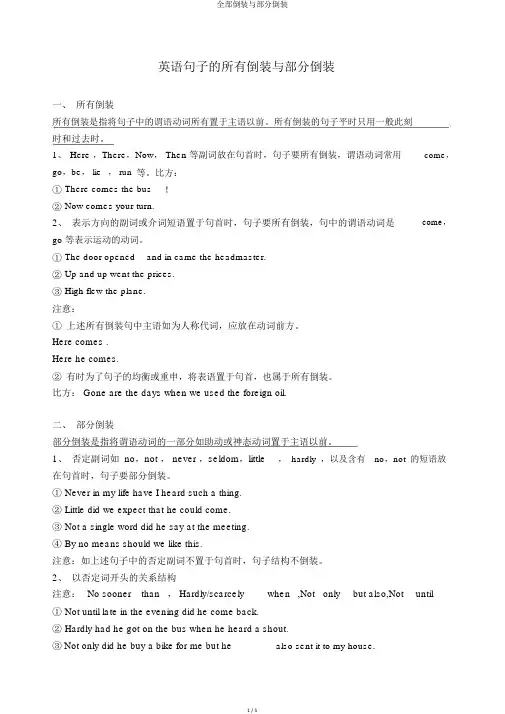
英语句子的所有倒装与部分倒装一、所有倒装所有倒装是指将句子中的谓语动词所有置于主语以前。
所有倒装的句子平时只用一般此刻时和过去时。
1、Here ,There,Now, Then 等副词放在句首时,句子要所有倒装,谓语动词常用come,go,be, lie , run 等。
比方:①There comes the bus !②Now comes your turn.2、表示方向的副词或介词短语置于句首时,句子要所有倒装,句中的谓语动词是come,go 等表示运动的动词。
①The door opened and in came the headmaster.②Up and up went the prices.③High flew the plane.注意:① 上述所有倒装句中主语如为人称代词,应放在动词前方。
Here comes .Here he comes.② 有时为了句子的均衡或重申,将表语置于句首,也属于所有倒装。
比方: Gone are the days when we used the foreign oil.二、部分倒装部分倒装是指将谓语动词的一部分如助动或神态动词置于主语以前。
1、否定副词如 no,not , never ,seldom,little,hardly,以及含有no,not的短语放在句首时,句子要部分倒装。
①Never in my life have I heard such a thing.②Little did we expect that he could come.③Not a single word did he say at the meeting.④By no means should we like this.注意:如上述句子中的否定副词不置于句首时,句子结构不倒装。
2、以否定词开头的关系结构注意:No sooner than , Hardly/scarcely when ,Not only but also,Not until①Not until late in the evening did he come back.②Hardly had he got on the bus when he heard a shout.③ Not only did he buy a bike for me but he also sent it to my house.注意: No sooner than ; hardly when;not only but also这种句型,只将前半部分倒装,后半部分用正常语序。
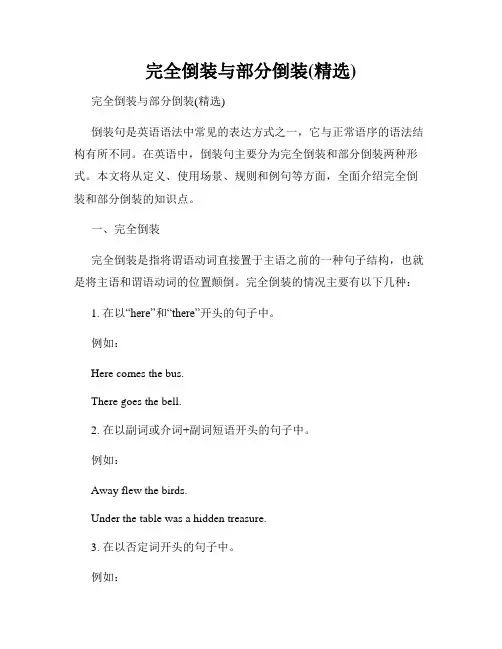
完全倒装与部分倒装(精选)完全倒装与部分倒装(精选)倒装句是英语语法中常见的表达方式之一,它与正常语序的语法结构有所不同。
在英语中,倒装句主要分为完全倒装和部分倒装两种形式。
本文将从定义、使用场景、规则和例句等方面,全面介绍完全倒装和部分倒装的知识点。
一、完全倒装完全倒装是指将谓语动词直接置于主语之前的一种句子结构,也就是将主语和谓语动词的位置颠倒。
完全倒装的情况主要有以下几种:1. 在以“here”和“there”开头的句子中。
例如:Here comes the bus.There goes the bell.2. 在以副词或介词+副词短语开头的句子中。
例如:Away flew the birds.Under the table was a hidden treasure.3. 在以否定词开头的句子中。
例如:Never have I seen such a beautiful sunset.Not only did he pass the exam, but he also got the highest score.4. 在以“only”开头的句子中。
例如:Only in this way can we solve the problem.Only when we work together can we achieve success.二、部分倒装部分倒装是指将助动词、情态动词或连系动词置于主语之前的一种句子结构。
部分倒装常常出现在以下情况下:1. 在以否定词开头的句子中。
例如:Never have I been so disappointed.At no time did she mention the incident.2. 在以“so”开头表示结果的句子中。
例如:So excited was he that he couldn't fall asleep.So tired was she that she couldn't continue the journey.3. 在以“not only...but also...”开头的句子中。
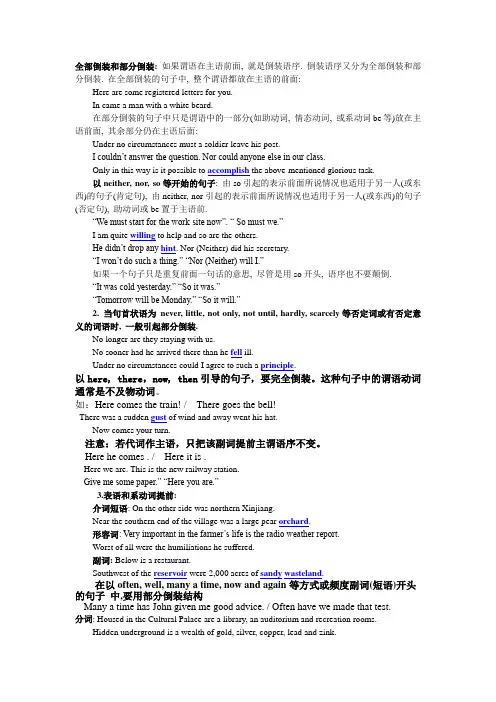
全部倒装和部分倒装:如果谓语在主语前面, 就是倒装语序. 倒装语序又分为全部倒装和部分倒装. 在全部倒装的句子中, 整个谓语都放在主语的前面:Here are some registered letters for you.In came a man with a white beard.在部分倒装的句子中只是谓语中的一部分(如助动词, 情态动词, 或系动词be等)放在主语前面, 其余部分仍在主语后面:Under no circumstances must a soldier leave his post.I couldn’t answer the question. Nor could anyone else in our class.Only in this way is it possible to accomplish the above-mentioned glorious task.以neither, nor, so等开始的句子: 由so引起的表示前面所说情况也适用于另一人(或东西)的句子(肯定句), 由neither, nor引起的表示前面所说情况也适用于另一人(或东西)的句子(否定句), 助动词或be置于主语前.“We must start for the work-site now”. “ So must we.”I am quite willing to help and so are the others.He didn’t drop any hint. Nor (Neither) did his secretary.“I won’t do such a thing.” “Nor (Neither) will I.”如果一个句子只是重复前面一句话的意思, 尽管是用so开头, 语序也不要颠倒.“It was cold yesterday.” “So it was.”“Tomorrow will be Monday.” “So it will.”2. 当句首状语为never, little, not only, not until, hardly, scarcely等否定词或有否定意义的词语时, 一般引起部分倒装.No longer are they staying with us.No sooner had he arrived there than he fell ill.Under no circumstances could I agree to such a principle.以here, there,now, then引导的句子,要完全倒装。
完全倒装与部分倒装通用版完全倒装和部分倒装是英语语法中常见的句子结构形式。
倒装是指将句子的主语和谓语动词的顺序颠倒。
完全倒装是将整个谓语动词移到主语之前,而部分倒装是将助动词、情态动词或者一些表示地点、时间的副词放在主语前面。
本文将详细介绍完全倒装和部分倒装的用法和常见例子。
一、完全倒装1. 在以here, there, out, in, up等地点副词开头的句子中。
例如:- Here comes the bus.- There goes the bell.2. 在以never, seldom, rarely, little, hardly等表示否定意义的副词开头的句子中。
例如:- Never have I seen such a beautiful sunset.- Seldom does he go out at night.3. 在以"Only + 状语"开头的句子中。
例如:- Only in this way can you improve your English.- Only by working hard can we achieve success.4. 在以否定词开头的句子中,如never, not, no sooner等。
例如:- Never had I tasted such delicious food.- Not until the exam is over will we be able to relax.5. 在以“so/such + adj./adv. + that”开头的句子中。
例如:- So loud was the music that we couldn't hear each other.- Such is his talent that he can play multiple instruments.6. 在以“here/now + 系动词 + 主语”开头的句子中。
部分倒装与完全倒装的区别英语最基本的词序“主语部分+谓语部分”通常十分固定。
如果把谓语动词放在主语前面,这就叫做倒装。
将谓语动词完全移至主语之前,称为完全倒装;如果只是把助动词或情态动词放在主语之前,称为部分倒装。
一、全部倒装1.以here,there,now,then开头的句子,谓语动词要放在句子的主语之前。
这种句子中的谓语动词通常是不及物动词。
如:Here comes the train!There goes the bell!注意:如果句子的主语是人称代词,则不能使用倒装结构。
如:Here it comes!/There it goes!2.有些动词短语以副词out,in,up,down,away等结尾,构成不及物动词短语。
这时,为了使句子更形象,常将这些副词提前到句首。
这时,句中的谓语动词要放在句子主语的前面,构成全部倒装。
(注意,这时句子的主语也必须是名词。
如果是人称代词,也不能使用倒装结构。
)如:Up went the rocket.Up it went.3.为了强调表示地点的介词短语,常将这个介词短语放在句首,构成全部倒装。
注意,这时句子的谓语动词通常是不及物动词。
如:In the front of the lecture hall sat the speaker.4.表语置于句首,且主语较长或结构较复杂的句子要用全部倒装。
如:Gone are the days when we had nothing to eat.5.so/neither/nor表示前面所说的情况也适合于后者,其倒装结构为“so/neither /nor+助动词/系动词/情态动词+主语”(so表示肯定意义,neither/nor表示否定意义)。
如:She has finished her homework,so has her brother.She hasn’t gone there,neither/nor has he.但如果so表示强调,即强调前面所说的情况的真实性时,其结构是“so+主语+助动词/系动词/情态动词”,这里的主语同前一个句子的主语指的是同一人或物。
全部倒装和部分倒装知识点倒装是英语中的一种语法结构,常见于特殊句型或句子的词序变换。
倒装分为全部倒装和部分倒装两种形式。
全倒装是指谓语动词与主语互换位置,而部分倒装是指谓语动词中的助动词或其他辅助动词与主语互换位置。
一、全部倒装1. 在以表示方向、距离、时间等副词开头的句子中,常用全部倒装结构,即把谓语动词完全提到主语之前。
常见的副词有here, there, now, then等。
例如:There goes the bell. (这是句确句式,意思是“铃响了。
”)2.以否定副词开头的句子也常用全部倒装。
例如:Never have I seen such a beautiful sunset. (我从未见过如此美丽的日落。
)Rarely do we go to the cinema. (我们很少去电影院。
)3.在倒装句中,当句首为状语从句时,主句也要全部倒装。
例如:If only I had known the truth, I would have acted differently. (要是我早知道真相,我会有所不同的行动。
)When she arrived, so did he. (她到达时,他也到了。
)4.在以“介词+疑问词”开头的句子中,常用全部倒装。
例如:By what means was he able to escape? (他是用什么方法逃脱的?) With whom did you go to the party? (你和谁一起去的派对?)二、部分倒装1. 当句子以否定词或含有否定意义的词开头时,助动词或系动词要与主语调换位置,并在助动词或系动词后加not。
例如:They are not studying English. (他们不在学英语。
)2. 当so/such引导的结果状语从句位于句首时,要进行倒装。
例如:So tired was he that he fell asleep immediately. (他太累了,以至于立刻睡着了。
全部倒装和部分倒装: 如果谓语在主语前面, 就是倒装语序. 倒装语序又分为全部倒装和部分倒装. 在全部倒装的句子中, 整个谓语都放在主语的前面:Here are some registered letters for you.In came a man with a white beard.在部分倒装的句子中只是谓语中的一部分(如助动词, 情态动词, 或系动词be等)放在主语前面, 其余部分仍在主语后面:Under no circumstances must a soldier leave his post.I couldn’t answer the question. Nor could anyone else in our class.Only in this way is it possible to accomplish the above-mentioned glorious task.以neither, nor, so等开始的句子: 由so引起的表示前面所说情况也适用于另一人(或东西)的句子(肯定句), 由neither, nor引起的表示前面所说情况也适用于另一人(或东西)的句子(否定句), 助动词或be置于主语前.“We must start for the work-site now”. “ So must we.”I am quite willing to help and so are the others.He didn’t drop any hint. Nor (Neither) did his secretary.“I won’t do such a thing.” “Nor (Neither) will I.”如果一个句子只是重复前面一句话的意思, 尽管是用so开头, 语序也不要颠倒.“It was cold yesterday.” “So it was.”“Tomorrow will be Monday.” “So it will.”当句首状语为never, little, not only, not until, hardly, scarcely等否定词或有否定意义的词语时, 一般引起部分倒装.No longer are they staying with us.No sooner had he arrived there than he fell ill.Under no circumstances could I agree to such a principle.表示位置或方向的副词提前, 谓语动词为go, come等表示位置转移的动作动词而主语又较长时, 通常用全部倒装:There was a sudden gust of wind and away went his hat.The door burst open and I rushed the crowd.There comes the bus!Now comes your turn.如果主语是代词, 仍用正常语序:There comes your turn.有here引起, 谓语为be的句子, 也要倒装:Here is China’s largest tropical forest.Here are some picture-books.如果主语是代词, 仍用正常语序:Here we are. This is the new railway station.“Give me some paper.” “Here you are.”表语和系动词提前:介词短语: On the other side was northern Xinjiang.Near the southern end of the village was a large pear orchard.形容词: Very important in the farmer’s life is the radio weather report.Worst of all were the humiliations he suffered.副词: Below is a restaurant.Southwest of the reservoir were 2,000 acres of sandy wasteland.分词: Housed in the Cultural Palace are a library, an auditorium and recreation rooms.Hidden underground is a wealth of gold, silver, copper, lead and zink.Lying on the floor was a boy aged about 17.Standing beside the table was an interpreter.6) 句首状语若由only + 副词, only + 介词词组, only + 状语从句构成, 引起局部倒装:Only yesterday did he find out that his watch was missing.Only through sheer luck did he manage to get some tickets.Only because there were some cancelled bookings did he get some tickets in the end.有not only开头的句子或分句, 往往引起局部倒装:Not only did he complain about the food, he also refused to pay for it.Not only did the garage overcharge me, but they hadn’t done a very good repair job either.。
全部倒装与部分倒装区别英语句子一般主语在前,谓语在后,但有时因为语法结构的要求或由于修辞的要求,要改变句子的自然语序,把一些本应置于主语之后的成分提前,我们称这种语序为倒装语序。
解释1:部分倒装—是指将谓语的一部分如系动词,助动词或情态动词倒装至主语之前。
如果句子的谓语没有助动词或情态动词,则需添加助动词do, does或did,并将其置于主语之前。
解释2:完全倒装即把整个谓语放到主语之前In came the teacher and the class began. (老师走了进来,然后开始上课。
)部分倒装即只把谓语的一部分(如助动词、情态动词等)放到主语前,或把句子的强调成分提前。
Nor did he let the disease stop him from living the kind of life he has always dreamt about(疾病没有使他放弃过上梦想中的生活)解释3:为了表示强调,经常将never等否定副词或by no means等杏定词组放在句首,此时句子要求将系动词、助动词或情态动词放在主语之前,而谓语部分位置不变,这就是部分倒装。
Not until yesterday did little John change his mind.直到昨天小约翰才改变主意。
完全倒装是主语和谓语完全颠倒。
如;Here comes the bus. 公共汽车来了。
There goes the bell. 铃响了。
解释4:英语句子的自然语序是“主语+ 谓语”。
如果将谓语的全部或一部分放在主语之前,这种语序被称为“倒装”。
谓语全部放在主语之前,为全部倒装;只把助动词,连系动词或情态动词放在主语之前,为部分倒装。
倒装的原因,一是语法结构的需要(如某些疑问句);二是为了强调;三是保持句子的平衡或是上下文紧密相接解释5:英语句子的结构一般是“主语+ 谓语”,语法上称这种语序为自然语序。
英语的倒装句可分为两大类:全部倒装呵部分倒装倒装句英语的倒装句可分为两大类:全部倒装呵部分倒装。
一、全部倒装全部倒装是指将句子中的谓语动词全部置于主语之前。
全部倒装的句子通常只用一般现在时和过去时。
1、Here,There,Now,Then等副词放在句首时,句子要全部倒装,谓语动词常用come,go,be,lie,run等。
例如:? There comes the bus~? Now comes your turn.2、表示方位的副词或介词短语置于句首时,句子要全部倒装,句中的谓语动词是come,go等表示运动的动词。
? The door opened and in came the headmaster.? Up and up went the prices.? High flew the plane.注意:? 上述全部倒装句中主语如为人称代词,应放在动词前面。
Here comes Mr.Lee.Here he comes.Auay went the students.Auay they went.? 有时为了句子的平衡或强调,将表语置于句首,也属于全部倒装。
例如:Gone are the days when we used the foreign oil.二、部分倒装部分倒装是指将谓语动词的一部分如助动或情态动词置于主语之前。
1、否定副词如no,not,never,seldom,little,hardly,以及含有no,not的短语放在句首时,句子要部分倒装。
? Never in my life have I heard such a thing.? Little did we expect that he could come.? Not a single word did he say at the meeting.? By no means should we do like this. 注意:如上述句子中的否定副词不置于句首时,句子结构不倒装。
2011年职称英语理工类语法复习:全部倒装与部分倒装
全部倒装与部分倒装:
英语中,通常是主语在谓语动词的前面,是“主语+谓语”结构,这叫陈述语序,也称为正常语序,如果将谓语的全部或一部分放在主语之前,就称为倒装语序。
有的倒装语序把整个谓语动词放在主语之前,称为完全倒装,有的只是谓语动词的一部分(通常是助词,情态动词,系动词be或谓语的一部分)放在主语之前,称为部分倒装。
例如:
正常语序Her student stood by her side.她的学生站在她的边上.
倒装语序By her side stood her student·
正常语序We have rarely found him in such a good mood.我们很少看到他情绪那么好·倒装语序Rarely havewe found him in such a good mood·
1.否定词语置于句首
never.no,neither,hardly,scarcely,little,seldom,rarely,not until,nowhere,at no time,on n0 account.in no respects,in no sense,in no way,under no circumstances,by no means,no longer,no less,no more,no sooner,in vain
2.only+状语置于句首
only加副词:only then,only onceonly加介词短语:only at that time,only in this way,only by doing
only加状语从句:only because,only when
3.not only……but also……置于句首
4.80……that……状语、表语置于句首
5.than引导的比较状语从句(可以)
6.表语+系动词+主语
7.存在句(there be…)
8.as引导的让步状语从句。